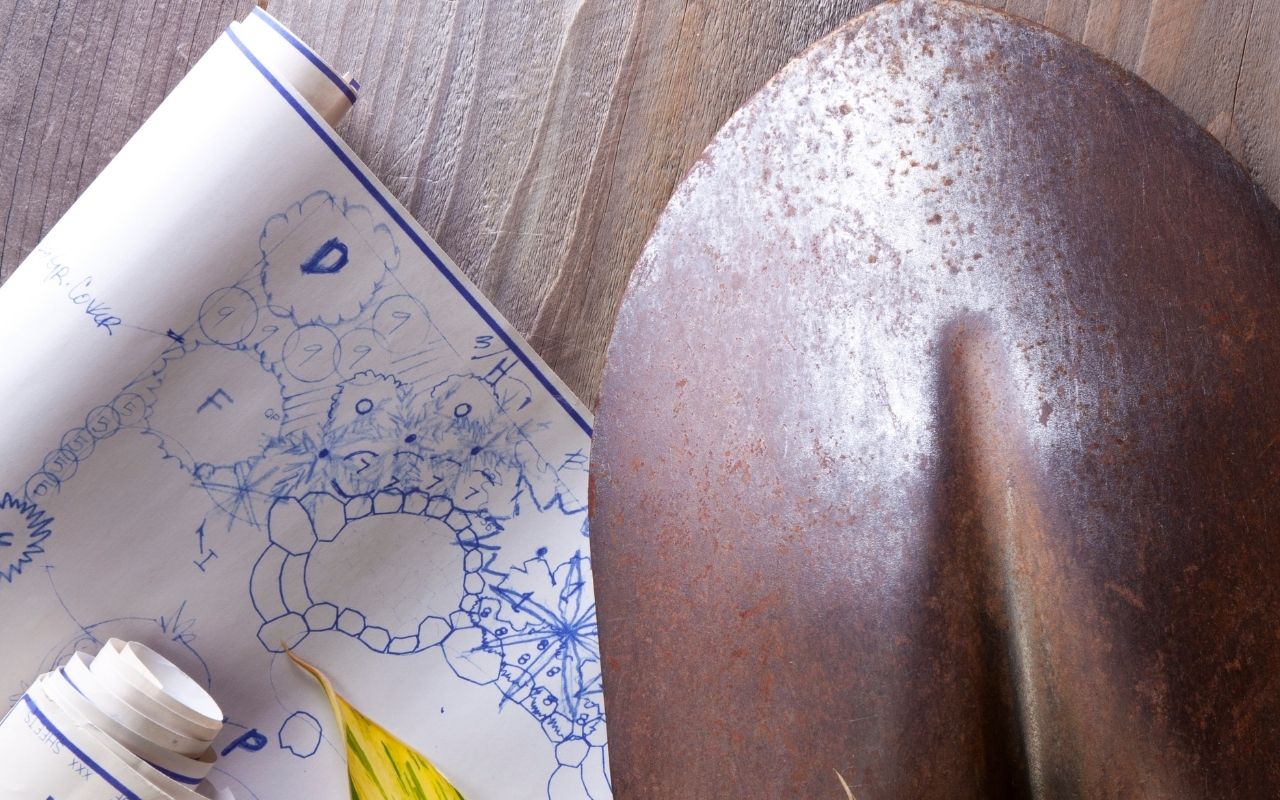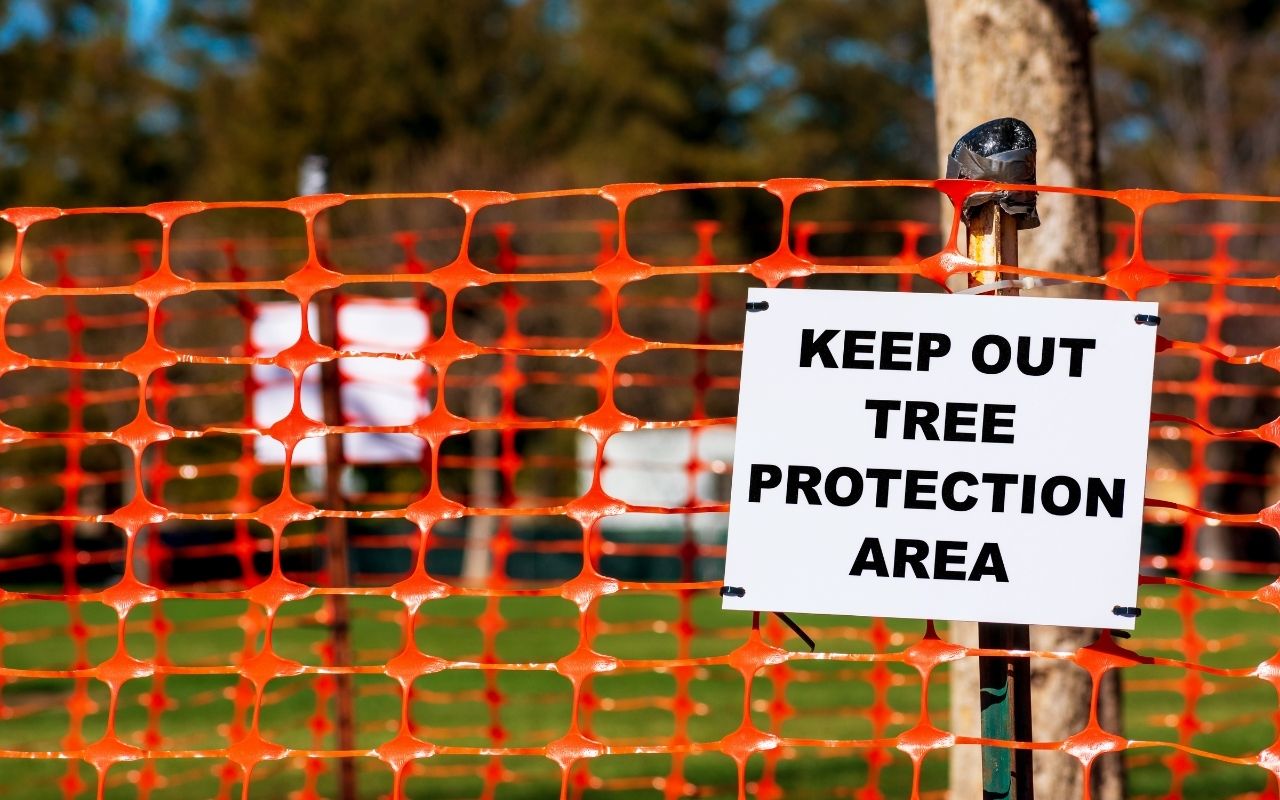
How Landscaping & Construction Can Kill Trees
Planning a construction or landscaping project on your northern Virginia property, large or small, can be stressful for everyone involved – including your trees. Whether you plan to install a sidewalk, add a hot tub, build a porch, or construct a fence, any construction project on your property can negatively impact the health and longevity of your trees.
In this article, we:
- explain the many ways in which landscaping and construction projects can harm, and even kill your trees,
- how to plan for and prevent potential problems before the project begins,
- ways to protect your trees while work is in progress, and
- how to help your trees recover after you’re enjoying the results of your project.
How Construction & Landscaping Projects Can Harm Trees
The heavy, powerful equipment that makes construction projects easier and quicker is not designed to protect trees. Without a tree protection plan, even skilled, experienced construction and landscaping contractors can inadvertently harm your trees. To prevent tree and tree root damage during projects (even smaller projects!), it’s important you know how construction damage occurs.
Here are the most common ways that construction (and landscaping!) work can damage your trees.
1. Compacting the Soil
The most damaged part of many construction sites is the existing soil.
During a construction project, you can expect to have a lot of heavy items on your property, including:
- heavy vehicles such as trucks, cranes, and backhoes,
- heavy equipment such as concrete mixers, and
- stockpiled materials and debris.
The weight of all these is transferred directly to the soil, where it compacts soil particles.
Healthy soil is about 50% air and water spaces; the rest is minerals and organic matter. When soil particles are compacted, the spaces around them are too. Without open spaces, the soil can no longer absorb, filter, and move water, and tree roots can no longer find oxygen.
Virginia Tech has information on how compacted soil can be repaired to help trees. But the best and least expensive option is to protect your soil before work begins.
2. Cutting Tree Roots
Damaging or cutting tree roots is one of the most common ways trees are harmed during construction. Trenching for irrigation or utility lines, digging foundations, putting in a pond or pool, grading, and other work can all disturb or sever roots.
It’s difficult to avoid disturbing the roots of existing trees; they’ve grown into the soil wherever nutrients and water were found, and you can’t predict their location.
But it’s critical to your trees’ health to protect their roots. A tree’s roots both anchor it securely in the soil and send vital water and nutrients up to all parts of its crown.
If you have mature, valuable trees, have an arborist examine them before you plan your construction project. This way you’ll have time to modify your project’s design to keep your trees’ roots intact.
3. Paving Over Tree Roots
Root damage will happen if you pave over tree roots to create a new path, patio, or driveway. Your existing trees have developed their root system in relation to the soil’s surface level, and you don’t want to change that.
Paving over those roots with materials like concrete, asphalt, pavers, or brick will smother tree roots, eventually killing them.
Even worse, because tree roots are made of organic matter, dead roots will decay over time. This makes the paving base unstable, causing cracks and shifting in your new patio or walkway.
4. Excavating Soil During Construction
Depending on the scope of your construction project, you may need to dig out the soil.
Common reasons for this include:
- connecting underground utility lines,
- adding irrigation lines,
- pouring foundations, and
- setting fence posts.
All of these construction activities can harm your trees and their roots. Trenching and digging machines are designed to rip out everything in their way. Have a local tree care expert advise your contractor on how to minimize tree damage during excavation.
5. Adding or Removing Soil
Just like adding paving, adding soil on top of your existing trees’ roots will suffocate them. Even temporary soil stockpiling is damaging, so make sure any stored topsoil is kept away from tree roots. And removing soil, even just a few inches of it, can expose tree roots, scrape off their outer surface, and compromise their ability to firmly anchor the tree.
If you have existing trees, the soil level around them should remain the same during and after the project work is done.
6. Damage from Equipment
Another common way trees are damaged during construction is from equipment. Cranes and backhoes can easily break off tree branches and gouge bark, which creates openings for insects and diseases to get into your trees.
Your project plan should include protection against damage from vehicles and equipment.
7. Chemical Washing and Dumping
If you’re having concrete poured during your construction project, make sure your contractor uses a concrete washout container. Concrete residue in the soil will change its pH, making the soil more alkaline and inhospitable for your existing trees.
The cement and aggregate (rocks) used in concrete may contain soil-contaminating heavy metals, such as cadmium and nickel. Similarly, any solvents and oils used for cleaning, sealing, or gluing should not be washed into your soil.
How to Prevent Construction Damage to Your Trees
In northern Virginia, trees in urban areas are already challenged by small planting spaces, limited soil volume, and air pollution. Construction and landscape project damage will add to their distress and may even kill them. Thankfully, there are things you can do to avoid this fate.
Create a Tree Protection Plan
Tree preservation during construction is key to protecting your trees from damage during a construction project.
Before you plan your construction project, have your trees evaluated by a tree care professional and work with them to make a tree protection plan. The tree experts at Green Vista Tree Service can explain what sort of protection you need.
Depending on the number of trees you have, you may want to measure their size and add their precise location to a tree protection plan drawing. Whether or not you need a plan drawing, always photograph your trees before construction to document their condition.
Give Your Trees What They Need
If your construction project involves turning off an existing irrigation system, make sure you have a temporary watering system in place. This will keep your trees from becoming water-stressed and help them remain resistant to other environmental stressors.
How to Protect Your Trees During Construction
Once work gets underway, you’ll need to ensure that your trees are well-protected throughout the entire project. Here’s what to do:
Follow Your Tree Protection Plan
A plan is only good if it’s actually followed! If you have a tree protection plan, give it to your contractor. Make sure everyone follows the plan and installs all safety measures the plan describes.
Use Safety Fencing
High-visibility safety fencing is commonly used to block off areas around existing trees and keep vehicles and equipment away from their root zone. Have warning signs attached to the fencing to remind crews to stay away.
Apply Temporary Mulch
Apply a thick layer of mulch (6”) to the soil around trees during construction. Mulch will cushion the soil and protect it. When construction is done, remove the mulch and discard it, especially if there is construction debris in it.
Keep Construction Materials Away From Trees
Before construction begins, designate an area well away from trees for storing or stockpiling materials. Choose an area that’s convenient for material delivery and for sorting and moving materials.
Use Construction Mats or Plywood
Protect your trees by laying rigid sheets of plywood or metal over the soil. Add a six-inch layer of mulch below the mats to cushion the soil and distribute the weight of stored materials and vehicles.
Keep Equipment Away From Trees Whenever Possible
All equipment that’s on-site during construction should be kept away from trees and tree roots. This will prevent damage to your trees’ trunks and branches.
Prune Branches Before the Work Starts
If your trees have branches that may conflict with construction work or maybe damaged by equipment, have them professionally pruned before any work starts. This will prevent torn bark and ragged wounds that can attract insect pests or become infected.
How to Help Your Trees Recover After the Project Is Completed
What you do after the project is finished depends on the condition of your trees. As soon as construction is finished, closely examine your trees for damage.
If Your Trees Are Damaged
If you notice any damage, such as broken branches or torn bark, immediately call an experienced tree care pro for an evaluation. If it’s serious, they’ll be able to address the problem with pruning or wrapping.
Wounds in a tree’s bark caused by tearing or abrading create entries for pests and diseases, so it’s important to have them treated before the problem worsens.
If you’re not sure a tree can be salvaged, contact the professionals at Green Vista Tree Service for an evaluation.
If You Lose a Tree
Despite your best efforts, sometimes trees cannot be saved after construction damage. Or, sometimes, they must be removed before the work starts to make way for equipment or installation.
If you need to plant replacement trees after construction, we can help you to choose the right tree for the right space.
If You Don’t Notice Any Damage
Even with careful construction practices, your trees will want some extra care after your project is finished.
- Give your trees plenty of irrigation, especially during periods of drought or hot weather, and even during the winter
- Gently fertilize to help new growth
- Watch out for common tree pests that are drawn to stressed trees (because even if your trees look healthy, they will still be stressed from any landscaping or construction work done nearby)
A Final Note
If you’re planning any construction projects, call us first at 571-244-3838! As experienced tree care professionals, we can help keep your trees healthy and protected before, during, and after construction.
In need of tree care services?
Give us a call at 571-244-3838 or request a quote online!
More Articles From Green Vista Tree Care










